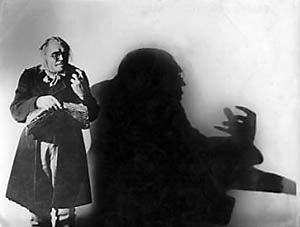After the First World War the German filmmakers trained and influenced by the German expressionist movement found difficult to create movies that could be compared with the expensive features coming from Hollywood and for this reason they started conceiving and developing their own style by using symbolism and a "mise en scene" more focused on the mood, atmosphere and human experiences.
Expressionist movies made up for a luck of money and investors by using simple and conceptual set designs with painted panels/canvas to represent lights, shadows and objects.
The plots and stories were mainly focused on themes such as madness, mental instability, double personality, anxiety and other intellectual and psychological topics.
In this movie genre there is a direct and strong relationship between cinema and architecture and strong elements of monumentalism and modernism are constantly used and addressed.
This genre of movies can be considered the father of later horror movies and "film noir", besides the fact that some similar spatial and architectural features can be depicted in contemporary movies such as Blade Runner(by Ridley Scott) and some of Tim Burton's movies. In this movie genre there is a direct and strong relationship between cinema and architecture and strong elements of monumentalism and modernism are constantly used and addressed.
In the creation of space, set design and architecture expressionist were giving a key role to shadows and lights, elements highly used to suggest and represent the mood of the characters and to lead the viewer through a dark and anxious mood.
EXAMPLES OF EXPRESSIONIST MOVIES
THE CABINET OF DOCTOR CALIGARI (Germany, 1920, Robert Wiene)
The Cabinet of Doctor Caligari is considered as one of the most influential movie within the German expressionist movement and is also regarded as the father of all the following horror movies.
The representation of spaces and architecture in the movie is extremely interested and innovative for the time in addition to the fact that it is really effective in creating an horror atmosphere and projecting in the space the mood and the mind of the characters.
Lights and shadows are directly painted on set walls, floors and background and mainly the set behind the actors is flat although it gives a great effect and creates the right atmosphere. The staircase scene (below) shows a great examples in the use of lights and shadows to create the suspense atmosphere and to give that sense of fear and danger.






No comments:
Post a Comment